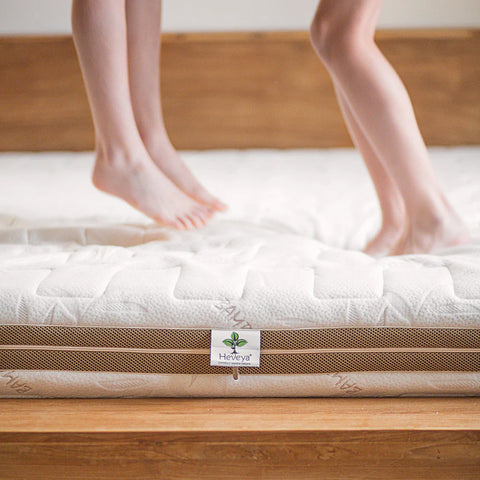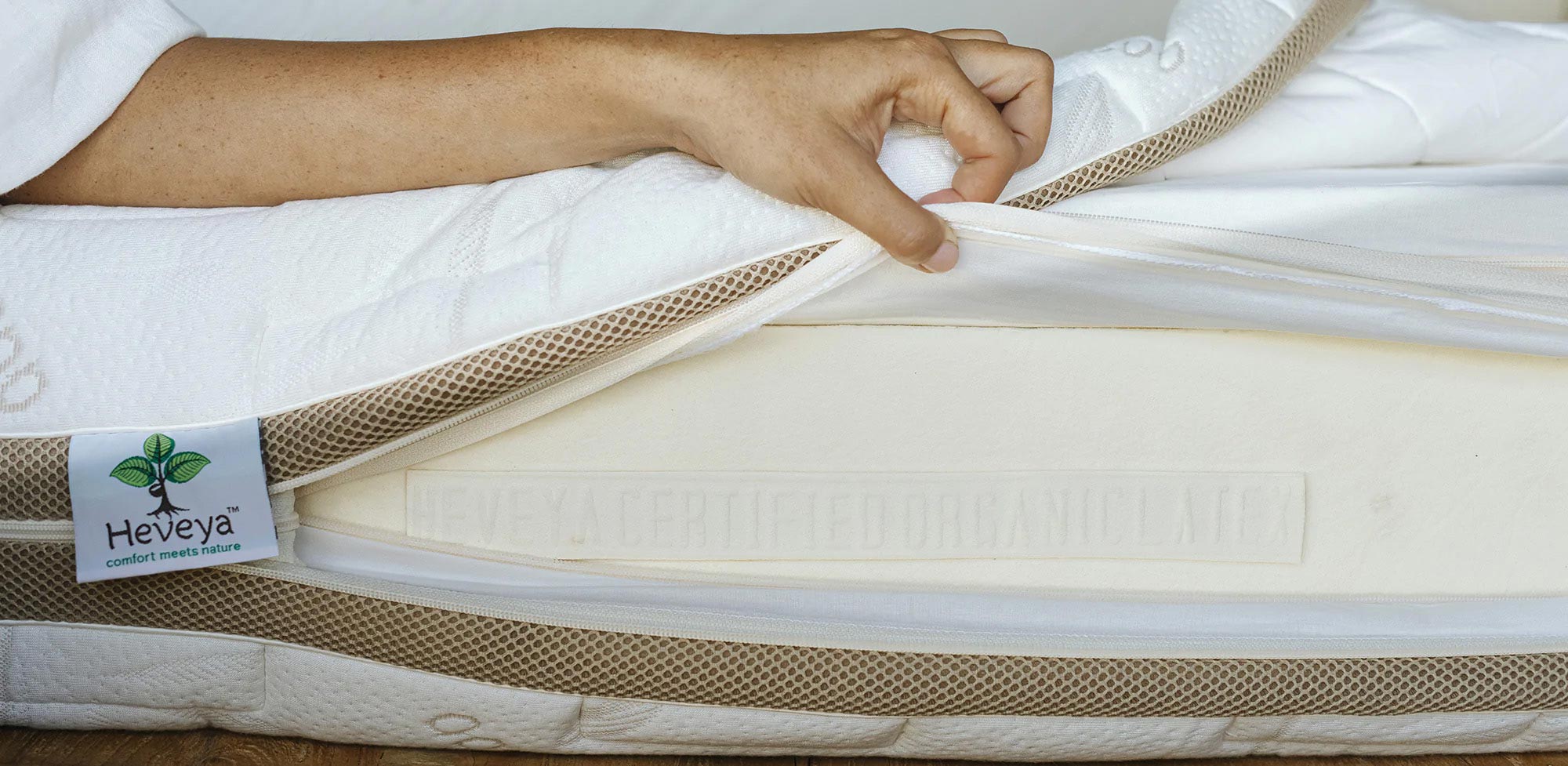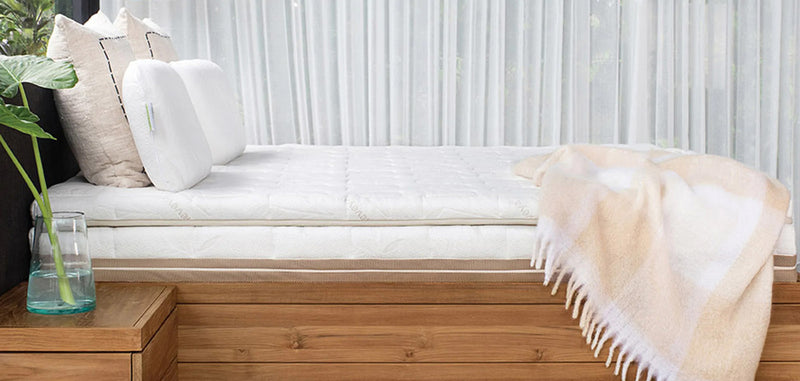With so many different mattress types out there, it can be difficult to know which is the most elastic and durable type of mattress. Fortunately though, we can look at mattress testing results.
Although people can talk about how comfortable their mattress is, the only way to really get objective quantitative results is to physically test the mattress. These tests are what we'll look at today.
Bounce eggs on latex
Yes, it's actually possible to bounce a raw egg on a latex mattress without the egg breaking1. So if a latex mattress can bounce the egg up into the air without any breakage, imagine how comfortable this mattress would feel to lie down upon. Latex is extremely springy and elastic due to its molecular structure. Yet it is also very comfortable and offers excellent body support.
Bounce a weight on latex
Even a heavy weight can still be bounced on a latex mattress with significant rebound1. This is further evidence of the elasticity of latex.
Most other types of mattress will offer little, if any, rebound to a heavy weight dropped on it. In contrast, latex mattresses are comfortably yielding yet offer plenty of elasticity.
Quantitative tests of latex elasticity and durability
The rebounding we learned about above with the eggs and the weight are qualitative tests - meaning you see these test results in a direct visual manner. However, if you instead wanted to get some hard numbers on the elasticity and durability of latex, we would need to turn to quantitative tests.
Fortunately, our principal supplier, Latexco, has carried out a lot of quantitative testing on the latex mattress cores in our products2. Let's take a look at some of these results.
Elasticity
The elasticity of a mattress is measured by the rebound height of a steel ball dropped from a specific height onto the mattress.
This elasticity is measured as a percentage of the rebound height compared to the original drop height. The higher the number, the more elastic the mattress is.
You will be pleased to know that results show latex has an elasticity of 60 - 70%2, which is better than other mattress types. Instead, PU foam mattresses have a much poorer elasticity of only 40 - 50%, as do HR foams at 50 to 60%2. Slow recovery foams, such as memory foam, have an even worse value of zero or negligible elasticity2.
Therefore, quantitative testing clearly shows that latex mattresses have the most elasticity compared to other mattress materials.

Durability
Testing the durability is done by simulating the load bearing during the expected full life span of a mattress. This is done by repeatedly rolling a 140kg weight up and down the mattress, for 30000 repetitions (yes, thirty thousand times!) After that, the decrease in height and hardness is measured and compared to the original height and hardness of the mattress. The results for latex show only a 3mm loss of height and a 3% loss in hardness after this process2.
These results show latex to be extremely durable under testing conditions designed to simulate normal use of the mattress during a full lifespan.
Testing the comfort of latex
You would expect a highly elastic and durable mattress to be comfortable, and it is. Yet for the sake of completeness, Latexco has run additional tests of factors that are more directly related to comfort. These factors are hysteresis, SAG factor and pressure distribution. Let's deal with each of these individually.
Hysteresis (energy absorption)
Hysteresis is a measure of the mattress's ability to compress and decompress when a load is put onto it. This is equivalent to how well the mattress absorbs energy. To test this, a weight is lowered onto the mattress with gradually increasing force, and then gradually released, while measuring the deforming and reforming the mattress.
Latexco mattresses give a hysteresis result of 20 - 30%2, in line with the 'happy medium' of hysteresis that will cause optimum comfort of around 20 - 30%. In contrast, mattress materials with a much lower hysteresis value means the mattress does not have enough 'give' - meaning the person sleeps 'above' the mattress2. At the other end of the spectrum, mattress types which have an overly high hysteresis value (e.g. memory foam) absorb so much energy that it then becomes difficult for the person to roll over.
So the hysteresis results show that latex falls in the range of optimum comfort in terms of its energy absorption.
SAG factor
The SAG factor is another indicator of comfort. It measures how well the mattress supports the body equally, and is related to how a latex mattress feels soft and first but then offers stronger support as you 'sink in'. This SAG factor is tested by the ratio of how much force is needed to compress the latex to 65% compression versus the amount of force needed for only 25% compression 2.
In this situation, the higher the SAG factor, the more comfortable the mattress will be.
Results from Latexco show a SAG factor ratio of near 4 for latex mattresses2, which is much better than the much lesser 2 - 3 ratio of PU foams2. This tells us that a latex mattress supports the body equally, delivering a very comfortable sleep.
Pressure distribution
For the sake of wellness and good blood circulation, a mattress should have an equal pressure distribution, and there should be no hard pressure points. Discomfort and poor blood circulation can result if there are local peak pressure points above 38mm Hg2.
The pressure distribution of a mattress is measured by a pressure mapping system of sensors while someone is laying down on it. Results from the measurements of Latexco mattress cores show that 99% of the measured points were less than the 38mm Hg2. This shows the latex mattress is comfortable and offers good blood circulation within the safe range.
Conclusion
As we saw from the test results above, a latex mattress is the most elastic and durable type of mattress. Not only that, but the latex mattress is also the most comfortable type. Testing of the comfort factors - hysteresis, SAG factor and pressure distribution - all showed results indicating a very relaxing and restorative mattress.
Of course, test results are no substitute for actually lying down on the mattress and trying it out! So why not come in and visit our showroom? You'll be able to test out the mattress and experience its luxury and comfort first-hand.














